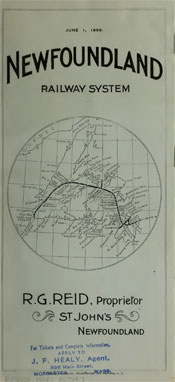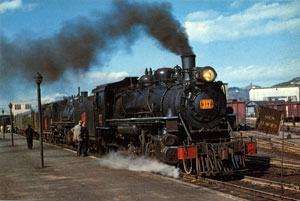Newfoundland Railway Reporting mark: NFLD
The Newfoundland Railway got off to a late start. It wasn't for lack of trying. The first survey was completed along the southern interior in 1868. It was followed by a second survey in 1875 across the centre of the island. But what the railway needed was a champion. He arrived in the form of William Whiteway, who became premier in 1878.

Source: www.archive.org
By 1880 the recommendations were in. Whiteway then spearheaded the plan to build a narrow-gauge railway running from St. John's to Halls Bay, a distance of some 340 miles (547 km) with a 27 mile (45 km) branch to Harbour Grace. The Newfoundland Railway Company, headed by New York lawyer A.L. Blackman, won the contract with construction beginning in August 1881.
By June of 1882 trains were running as far as Topsail, followed by service to Holyrood in September. But then things went horribly wrong. The company had completed 57 miles (92 km), almost as far as Whitbourne when it fell to receivership in 1883. The branch to Harbour Grace was eventually completed by the bondholders in 1884. Service was extended to Avondale in the spring of that year and then to Harbour Grace in the fall. In 1888 the government, which by then was headed by Robert Thorburn, completed a second branch to Placentia. Both the Harbour Grace and Palcentia branches were owned by the government.
In 1889 Whiteway was returned to power and the mainline project was renewed. This time the contract was awarded to R.G. Reid and G.H. Middleton, although Middleton bowed out of the partnership before completion. In 1893 the government made amendments to divert the route inland over the Gaff Topsails ending at Port aux Basques, a distance of some 285 miles (458 km). This required a new contract with Reid. In exchange for operating the railway for 10 years, Reid who also had substantial lumber interests, was granted 5,000 acres of land for each mile of track that he operated. The new extension was known as the Newfoundland Northern and Western Railway.
Reid made steady progress on the line. By June of 1898 the mainline was complete and trains were running from St. John's to Port aux Basques. In addition, Reid initiated a ferry service from Port aux Basques to North Sydney, Nova Scotia. In 1897, just prior to the general election, Reid was hired to build another three branch lines.
The election of 1897 resulted in a change of government headed by James S. Winter. Reid, along with sons William and Harry, cozied up to the new government and cut themselves a honey of deal, which later became known as the "1898 Railway Contract."
In exchange for operating the entire railway, as well asthe bankrupt Newfoundland Railway, the Harbour Grace Railway and the Placentia branch, Reid received grants of 5,000 acres for each mile. This was followed by outright ownership of the railway after 50 years. In addition the Reids purchased the government drydock for $325,000 along with the telegraph system.
The deal touched off a firestorm of controversy. Islanders were aghast when they discovered how much had been handed over to the Reids. Equally scandalous was the behaviour of government Finance Minister A.B. Morine, who was moonlighting as Reid's legal council during the contract negotiations. The government was booted from office in 1900 and replaced with a new government, headed by Robert Bond, Whiteway's successor. Under Bond, the government was able to make considerable amendments to the contract. Everything was placed under a limited liability corporation, the Reid Newfoundland Company. Reid lost ownership of the telegraph and railway but retained the right to operate the railway for the next 50 years, until 1951. There was an additional cost to the government of $850,000 to buy back 1.5 million acres of land from the Reids.

Photo: Tony Clegg, Publisher: JBC Visuals
Due to his vast land holdings, Reid quickly grew to become a major developer in Newfoundland. His efforts attracted further development and investors in both mining and forestry. At one point it was speculated that Reid Newfoundland was the largest employer in the colony. The election of 1909 led to the victory of Edward Morris, a Reid-backed politician who was inclined to be more favourable to the Reids' interests. Under Morris, the Reids were contracted to build five new branch lines, for a total of 282 miles (453 km). Two lines were later cancelled due to the war.
Railway construction was profitable however railway operations were not. According to one report, it cost the Reids 10 times more than the CPR to move one ton of freight. Part of the problem may have been the branch lines which catered primarily to passenger traffic and did not attract any new industries or development.
Like all railways, Reid Newfoundland was hard hit by World War I. Railway operations, which had been bleeding cash for years, had been subsidized by profitable railway construction. The war put an end to all construction projects. Upgrades and much-needed maintenance were also put on hold due to a shortage of labour and materials, coupled with high prices. Financial pressures were now taking their toll and the Reids wanted out.
By 1920, operating losses on the railway had ballooned to over $1.5 million per year. The situation was no longer sustainable. The government took over operations for one year and invested $1.5 million for repairs. Acting on recommendations from Sir George Bury, head of the CPR, the government agreed to cover up to an additional $1.5 million in operating losses. Despite making major cuts to services and wages, nothing changed. To force the government's hand, the Reids shut down the line for one week in May 1922. The government finally agreed to provide operating funds until July 1923 and then take possession of the railway.
Under the terms of the Railway Settlement Act the government paid Reid Newfoundland $2 million in exchange for the coastal boats and dry docks. This was primarily in recognition of improvements the Reid Newfoundland had made over the years. Reid Newfoundland retained ownership the lands granted to them in the earlier agreements as they were instrumental in the opening of a new pulp and paper mill in Corner Brook in 1925.
After nationalization, the railway became known as the Newfoundland Government Railway. In 1926 it was simplified to the Newfoundland Railway. Herbert Russell, a former Reid railway employee, was appointed general manger.
Russell had taken on a major challenge. Besides running a major operating deficit, the main line needed complete re-railing. The Depression brought a new wave of hardships, resulting in wage cuts, layoffs, service reductions and closures. A portion of the Carbonear branch was closed in 1931, followed by the Bay de Verde and Trepassey lines in 1931.
The railway's financial picture finally began to improve in 1936. The turning point was the construction of an airport and air force base in Gander, both of which were dependent on the railway.
World War II saw an increased military presence in Newfoundland followed by the construction of four American military bases. The Newfoundland Railway was a small but important part of the supply chain during wartime operations. Military and passenger traffic both surged. As Newfoundland was considered vital to the war effort, the railway qualified for locomotives, cars, and other equipment under "Land-Lease," a program offered by the Americans.
The Newfoundland Railway enjoyed its best days of profitability from 1936 to 46. By the end of the war, the railway was once again in need of major maintenance. In 1949 Newfoundland became part of Canada and the Newfoundland Railway was taken over by the Canadian National Railway (CN).
During the 1950s, CN made major investments in the railway. This included replacing all the steam locomotives with diesel, new rolling stock and improvements to the ferry service. However with the opening of the Trans-Canada Highway in 1965, the increased usage of trucks and buses began to take a toll on railway traffic. Passenger service was shut down in 1969 and replaced with buses. By the 1970s, the railway also began using more and more trucks to haul freight. The days of CN operations on Newfoundland were clearly numbered.
Part of the CN's problems originated with the narrow gauge track. Freight had to be unloaded from a standard gauge car once it arrived in Port aux Basques. From there it was delivered to a station or freight yard and then had to be reloaded on to trucks for its final destination. It took 20 days on average for rail delivery as opposed to six days by truck.
In 1978, the Sullivan Commission, which had been jointly appointed by the federal and provincial governments, released the Part 1 of its two-part report. The commission determined that rail was not viable in Newfoundland and likely never would be. It put forward a plan using a combination of road, sea and air. It further recommended that the railway be abandoned over a 10-year period.
The report must have warmed CN's heart. In 1976, the railway lost over $23 million in Newfoundland. Deregulation was on the horizon and CN could not compete as long as it was forced to subsidize money-losing operations.
In 1979 CN branched off the Newfoundland section into a new division called Terra Transport. The plan was to segregate Terra Transport from the mainline operations in an attempt to return it to profitability. Freight was transferred from cars to containers which could be easily loaded on to trucks. The plan worked for awhile but due to competition and other factors, customers once again began to move elsewhere.
In 1983 CN closed the Bonavista and Carbonear branch lines. The Argentia branch line followed the next year along with 32 stations on the main line. In 1985 the federal government recommended closing the railway.
In 1987 negotiations began between the province and the federal government. In 1988 the two parties cut a deal that became known as "Roads for Rails." In exchange for shutting down the railway, the federal government provided the province with $800 million to cover road improvements and severance packages for the CN employees. The railway was officially shut down on September 30, 1988.
Newfoundland's rail system was built when the road system itself was in its infancy. The railway helped to bring people and goods closer together. Most importantly it opened the interior of the province for explorations in new industries such as mining and forestry. However without a long-term and cohesive transportation plan, maintaining the railway was tenuous at best. Today Newfoundland and Labrador boasts an excellent highway system which is continually being expanded and improved. The combination of road, sea and air has worked well over the last 25 years and should continue to meet the province's transportation needs for many years to come.
